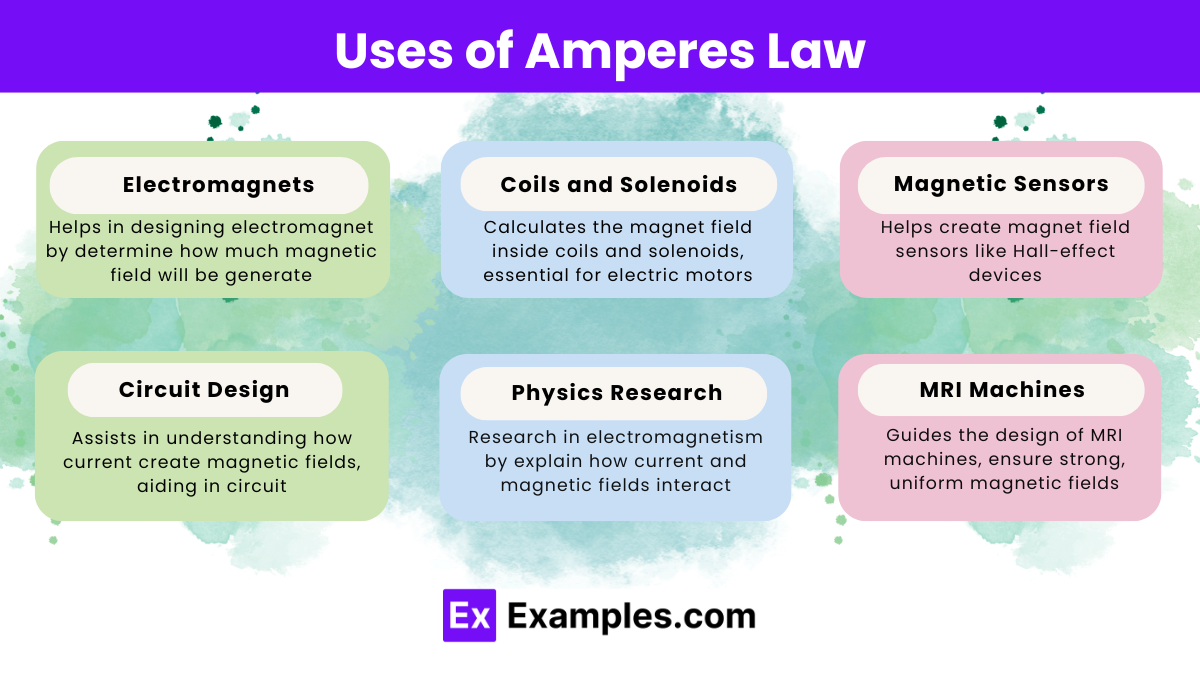What does Ampere's Law relate?
Electric field and charge distribution
Magnetic field and electric current
Gravitational field and mass
Magnetic field and voltage


Ampere’s Law is a fundamental concept in physics that describes the relationship between electric current and the magnetic field it produces. Part of the broader laws of physics known as Maxwells equations, Amperes Law states that the integral of the magnetic field around a closed loop is proportional to the total current passing through the loop.
André-Marie Ampère (1775-1836) was a French physicist and mathematician who is widely recognized as one of the founders of electromagnetism. His pioneering work laid the groundwork for the field of electrodynamics, which studies the interaction between electric currents and magnetic fields.
Ampère’s Circuital Law can be express as the line integral of the magnetic field around a closed loop being directly proportional to the total current passing through the loop.
If a conductor carries a current 𝐼, this flow of current generates a surrounding magnetic field.
The equation left side shows that the sum of the magnetic field along an imaginary path that encircle the conductor will numerical equal the current passing through that loop, denoted as 𝐼ₑₙ꜀
The formula for Ampere’s Law relates the magnetic field to the electric current passing through a closed loop:
This integral equation means that the line integral of the magnetic field around a closed path is proportional to the sum of the current passing through the enclosed area.
To find the magnetic field around a long, current-carrying wire at any distance 𝑟, apply Ampère’s Law using an imaginary loop surrounding the wire, as shown below:
Define an Amperian Loop: Encircle the wire with a circular loop (shown in blue) at a distance 𝑟 from the wire, forming a path of circumference 2𝜋𝑟.
Apply Symmetry: By symmetry, the magnetic field remains constant in magnitude along the loop, simplify the integral calculation.
Use Ampère’s Law: Apply Ampère’s Law: ∮𝐻⋅𝑑𝐿=2𝜋𝑟𝐻=𝐼ₑₙ꜀
where:
Solve for the Magnetic Field:
𝐻=𝐼ₑₙ꜀/2𝜋𝑟
The equation shows that the magnetic field decreases in magnitude as you move farther from the wire. According to the inverse relationship with distance 𝑟.
The field’s direction is tangential to the loop at every point and can be determined using the right-hand rule: if you point your thumb in the direction of the current, your fingers curl in the direction of the magnetic field.

Ampère’s Law relates a magnetic field around a closed loop to the current passing through the loop. It forms a key part of Maxwell’s equations, describe electromagnetism.
It calculates the magnetic field strength and direction created by a current, by considering the integral of the magnetic field around a chosen path.
An Amperian loop is an imaginary, closed path around a current-carrying conductor used to calculate the magnetic field via Ampère’s Law.
Symmetry simple the integral of the magnetic field around an Amperian loop, making it easier to calculate the magnetic field strength in symmetric configuration.
In solenoids, the law helps calculate the magnetic field inside the coil, which depends on the number of wire turns and the current.
Ampère’s Law shows that an increase in current directly strengthens the magnetic field around a conductor.
The law helps design electromagnet by calculate the magnetic field generate based on current, coil turns, and geometry.
Permeability measures a material ability to support a magnetic field, affecting the strength of the field calculate through Ampère’s Law.
Ampère’s Law deals with magnet fields and current, while Gauss’s Law relates electric fields to electric charges.
It is used in designing solenoids, transformers, electromagnets, and magnetic field shield for scientific research and practical applications like MRI machines.
Text prompt
Add Tone
10 Examples of Public speaking
20 Examples of Gas lighting
What does Ampere's Law relate?
Electric field and charge distribution
Magnetic field and electric current
Gravitational field and mass
Magnetic field and voltage
What is the integral form of Ampere's Law?
∮B·dl = μ₀I
∮E·dl = q/ε₀
∮B·dl = q/ε₀
∮E·dl = μ₀I
What does μ₀ represent in Ampere's Law?
Electric constant
Gravitational constant
Magnetic permeability of free space
Coulomb constant
How does Ampere's Law apply to a solenoid?
It shows the electric field inside the solenoid.
It shows the magnetic field inside the solenoid.
It shows the voltage across the solenoid.
It shows the charge distribution within the solenoid.
What is the magnetic field inside an ideal solenoid according to Ampere's Law?
B = μ₀nI
B = μ₀I/2πr
B = qvB
B = μ₀I/4πr²
Which law is a special case of Ampere's Law with Maxwell's correction?
Gauss's Law
Faraday's Law
Biot-Savart Law
Ampere-Maxwell Law
What does Ampere's Law state in the absence of a magnetic field?
The electric field is zero.
The current is zero.
The magnetic flux is constant.
The voltage is constant.
What is the relationship between the magnetic field B and the distance r from a long straight conductor according to Ampere's Law?
B ∝ r
B ∝ 1/r
B ∝ r²
B ∝ 1/r²
Which of the following is an application of Ampere's Law?
Calculating the electric field around a point charge
Determining the magnetic field inside a toroid
Finding the potential difference across a capacitor
Measuring the resistance of a wire
How is Ampere's Law used to derive the magnetic field inside a coaxial cable?
By integrating the electric field over the surface area
By measuring the current density in the cable
By calculating the voltage drop along the cable
By applying the law to a circular path inside the cable
Before you leave, take our quick quiz to enhance your learning!

